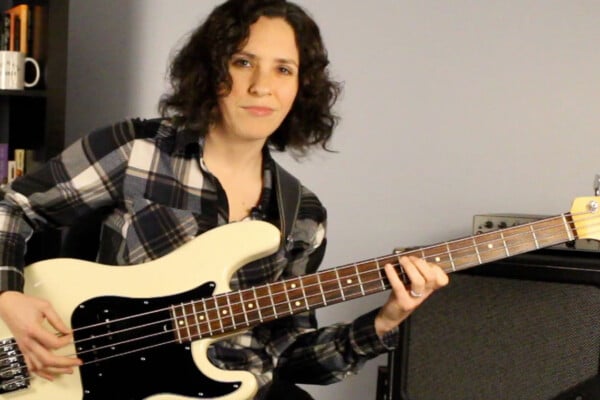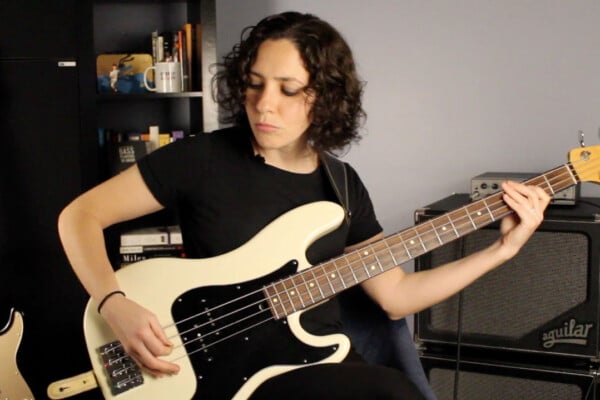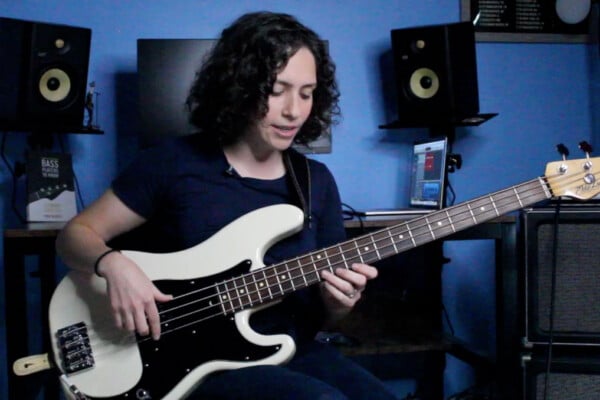Oppositional Structures in Melodic Construction: Imaginary Chords
Bass players need to become familiar with the principles of melodic construction for the creation of bass lines as well as solo lines.
One such principle is “oppositionality,” which we’ve talked about in previous columns. Oppositionality is the usage of non-harmonic tones to create tension and release against the underlying harmonic environment, contrasting against specific harmonic tones (targets). Some devices we’ve discussed include passing tones, neighbor tones, appoggiaturas, changing tones (cambiattas), suspensions and anticipations.
Another idea we’ve discussed is that of “approaches.” Approaches can consist of linear passages derived from the chromatic scale, the diatonic scale, or some other “chunk” of organization, such as an arpeggio, a diatonic series, or some intervalic array.
Let’s look at this:

These changes – or, to be exact, this chord symbol – constitute the first 2 “A” sections of “So What,” the seminal Miles Davis composition that opened the door to the “modal” era in jazz…
This is a lot of space to fill! One chord! What the heck are we supposed to do with it?
Answer: tension and release! “Call and Response.” Illustrate it and oppose it. Use chord tones, non-chord tones, chordal scales (the whole array of melodic devices), and “Imaginary Chords.”
What are “imaginary chords?”
Any harmonic environment can “host” any number of chord progressions derived from it without violating its essential function of being a “tonal center,” or “key” as in “key of…’x’.”
The musicians on the “So What” recording used the superimposition of some of these “imaginary” chords at some point, not in any particular sequence:




Progressions derived from tonal centers are frequently used by arrangers in the process of reharmonization of popular songs. From one point of view, this sort of harmonic embellishment is not reharmonization at all, but a development of the tonalites existing in the song. A true reharmonization would involve the substitution of another tonal center for the one intended by the composer.
There are other oppositional structures that can be employed in the melodic context; these would consist of intervalic arrays approaching a target from increasingly further back in time;

Their extensive development by musicians such as John Coltrane, McCoy Tyner, Chick Corea, Joe Henderson, Freddie Hubbard, Woody Shaw, Sonny Fortune, then later, Dave Liebman, Mike Brecker, and a host of others, created a whole new approach to improvisation with very individual results. This approach is used to develop improvisations on these kinds of chord changes (or lack thereof), bringing in a practically unlimited array of structures available on a seemingly constrained chord progression. Music that seems “out” or chaotic at first reveals itself to be highly structured, with the compositional process happening in real time with the listener as witness.




Jon,
could you explain what you mean by descending seconds and descending fourths in the example above. I think that the first step from D to A is throwing me off.Also the second two bars (ascending 4ths): I'm confused aren't these descending ex: B to F3, C to G?? I just what to make sure. Pls explain. Thanks! I follow you on Twitter. Thanks so much!
Hi, sorry if the example is confusing. The first example starts with a root and fifth, then the next 6 beats are pairs of seconds, descending by half steps. Once the pattern starts, its directionality is clear, making its sense of movement more prominent than its relationship to the underlying harmony – although its non-harmonic aspect is challenging to some ears. Don't do it on “Misty” as a first dance, if you follow me.
The second 2 bars are similar to the first in that the first 2 beats are a root and fifth, then the remaining 6 beats is a pattern consisting of 2 notes outlining a fourth; that 2-note pattern modulates by the interval of a half step, 3 times.
Hope that helps!
Video coming here in this space next week!
Best
Jon
thanks Jon! I get it!
thanks Jon! I get it!
Wow, this is excellent. I really like playing from left field as I’ve heard it called. My friends’ band was recording their demo when I first saw this technique used. I was only hearing the track he would be playing without the benefit of the entire mix, and it really had me confused. But hearing the big picture was truly eye opening. I had never considered how many levels are sometimes required for truly moving pieces of music.
New terminology to explain old harmonic concepts? What was wrong with “chromaticism” and “substitutions”? Ascending 4th’s- F to C is a 5th. Raising the F a half step to F# doesn’t change the relationship of the notes, they are fifths. A tritone to be exact. So that whole measure is walking chromatically ascending tritones up to the root of the chord. This entire article is more clearly explained in the last two sentences without using any new terminology. Music theory shouldn’t confuse, it should explain, and the simplest explanation that fits the facts is best.
It looks like he just mixed up the terminology on the 4ths, they should be labeled descending. If you start in the third measure it goes D,A,B,F# which are all descending 4ths. That continues through measure 4.